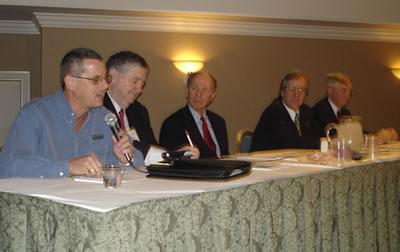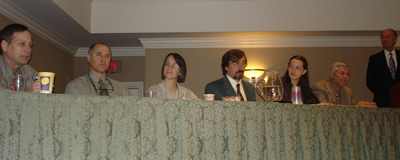Over 200 designers, engineers, manufacturers, fabricators, students, academics, and association members attended the NAGS / GRI-19 Cooperative Conference held December 14-16, 2005, at the Flamingo Hilton in Las Vegas, Nevada. After a full day of pre-conference gatherings (NAGS and IAGI Board Meetings, IAGI General Assembly, GSI Focus Group Meeting, Geo-Institute Task Force to discuss the developing document, Suggested Practices for Reinforced Walls and Slopes, and Geo-Americas Organizing Committee Meeting), an ice breaker was presented in the exhibit hall on Tuesday evening.
 |
Conference-goers started the morning with GRI’s first session, Use of Low Permeability Soils in Geosynthetic Reinforced Walls. Five speakers comprised the session (see speakers and papers below) followed by an enthusiastic panel discussion. There was much cross banter on where the problems lie in relation to failure – an age-old conversation. Dean Sandri caused a murmur in the crowd when he said that there was no shortage of structural engineers in the process, the problem is that "finding a geotechnical engineer is impossible! Structural engineers are designing the walls, but they must have a geotechnical background." He continued, "We aren’t doing a good job of policing our industry! It’s our own fault that these walls aren’t getting built properly."
More backing and forthing…the blame, or culpability, then jumped to the field and improper construction. Regarding low permeability soils and failure, Michael Simas argued quite eloquently – complete with slides – that he feels it is not so much an internal drainage design problem, but a construction/mulitple-stacking/compaction problem.
While Barry Christopher agreed that yes, it is critical to stack one block at a time, gravel fill, and compact as you go along…he is "not seeing this dictated in the design." Ball in designer’s court. Don Armstrong of Anchor Wall Systems took the floor and disagreed strongly. He said, "The specification is there. It is a quality control issue. But just because you write it – which we do – doesn’t mean it gets done." Back to the field.
Jim Collins, author of NCMA’s Design Drainage Manual, stated, "We need to change the contract method. We have to design walls for owners, not contractors." Barry Christopher then noted, "We have to reverse the practice." He is concerned that right now, the situation is "use drains in these instances, and really it should be drains must always be used – always – unless you can prove that you don’t need it."
Roberto Montalvo implored the audience to go to the source. "We need to talk to the people in the field." Meaning, explain the "where and why of the geosynthetic to the builder in the field. It’s our responsibility!" Quality control. Bob Koerner put it succinctly, "Poor construction will defeat even the best of designs."
John Paulson got up and spoke on Chip Fuller’s behalf (he had lost his speaking voice to one very cold and windy last sailing day of five). He read from Chip’s notes,
"Assuming that we all violently agree on these design issues, we collectively have a major problem mentioned by Jim Collins and Roberto Montalvo…In 2006, I estimate that over 10,000 SRWs will be built in the U.S. The vast majority of these are commercial applications with no input from geotech engineers. The SRW industry has taken on a life of its own, and in my opinion, less than 1% of the engineers stamping these plans will ever hear, or read, the valuable comments and papers presented here. How do we change the current model of price-driven engineering designs being done for contractors and installed by non-qualified installers?"
Bob Koerner mentioned that Home Depot, a company that will be needing SRWs in its geographically diverse potential locations around the country, is taking action in this arena.
 |
After the presentations were made, Thursday’s panel discussion focused first on how the engineering of heap leach pads is "pushing the envelope." Rick Theil wanted to commend the forward designs in heap leach pads saying, "it is some of the finest engineering I have seen." He sees more slippage in landfills. There is a lower factor of safety in mining, but there is less slippage, despite the fact that there is no "difference in design philosophy."
Charley Cobb, who works in mining and dams, disagreed, "The level of engineering in mining is poor." He commented that because the heap leach pad was not a landfill, the engineers push the envelope more, however he feels that care must be taken into account because "they are still fairly sensitive environments."
A query from the audience brought up the question of current monitoring instrumentation. Mauricio Ossa said that "one thing that is not very well known is conductive liners." Rick Theil added that the ‘most exciting area is the geoelectric surveys. It is nice to have conductive liners, but you don’t need them. With the water lance or dipole methods, you can find defects." One example he used was a case where holes in a liner were found in under six meters of ore in Argentina.
Dhani Narejo expressed concern in putting all the proverbial eggs in one basket regarding design and lab tests. "We see more damage in a field test than a lab test. Limitations on punctures depend on the field." He suggests that one should "do a test fill, and see what it takes. Fill material, drain cover, traffic, load – all are different each time. Trial and error is the best design you could possibly have."
Getting back to factors of safety for existing and new heap leach pads, Jay Swihart, mentioned that he is "not seeing any huge factors of safety" and is now "concerned that we are at the limit for the load of the pipe." Rick Theil answered by saying that while "most designs have pipe now, the regulations to have them there don’t exist." He wonders if pipes are even needed. "We’ve probably overkilled the pipe design." He then demonstrated, making a large circle with his index fingers and thumbs, that when a pipe collapses, it makes two smaller pipes (bringing his index fingers and thumbs together in the center). "It’s probably going to get crushed, but we design the flow to take that."
Below are the presentations made throughout the event. Please click here to order a copy of the proceedings.
NAGS 2005 Conference
Session #1 – Reinforcement in Static and Seismic Applications
J. Collin and S. Bhatia
Parametric Analysis of Reinforced Soil Walls with Different Backfill Material Properties
By K. Hatami and R. Bathurst
Influence of Various Parameters on Seismic-Induced Permanent Displacement of Geosynthetic Reinf
orced Segmental Retaining Walls
By A. Kadayifci and E. Guler
Experimental Investigation of Geofoam Seismic Buffers using a Shaking Table
By S. Zarnani, R. Bathurst and A. Gaskin
Landfill Construction over Peat Deposits – A Case History
By T. Soong, R. Paajanen and X. Qian
Session #2 – Geosynthetics in Based Reinforcement
J. Bowders and T-Y. Soong
Approach Embankment Supported by Geotextile Reinforced Sand Platform over Vibro Concrete Columns- A Case Study
By R. Wilson-Fahmy, S. Hanna, and R. Mankbadi
Use of Geosynthetics for Stabilizing Recycled Ballast in Railway Track Substructures
By B. Indraratna, M. A. Shahin, and W. Salim
Geosynthetic-Reinforced Column-Supported Embankment Design Guidelines
By J. Collin, J. Han, and J. Huang
Theoretical Analysis of Bending Stiffness Test of Geosynthetic-Reinforced Base Layer
By Z. Yuan
Interpretations of Behaviors of Reinforced Geotextile Composites
By H.-Y. Jeon, S.-H. Cho, and W.-S. Lyoo
Session #3 – Geosynthetics for Reinforcement in Pavement Systems and Perspective on Geosynthetic Education
K. Warren and S. Valero
Probabilistic Analysis of Geosynthetic-Reinforced Unpaved Road Subject to Subgrade
Variability
By P. Bourdeau
Comparison of a Mechanistic-Empirical Design Model to Measured Performance for Base-Reinforced Pavements
By S. Perkins and. E. Cuelho
Design and Build of a Small-Scale MSE Wall: January 2005 Geo-Challenge Competition
By E. Freeman (no paper)
Session #4 – Student Papers
K. Hatami and Craig Lake
Full Scale Geosynthetic-Reinforced Column-Supported Test Embankment
By A. Hassandi and T. Edil
The Short and Long Term Compressive Behavior of HDPE Geonet at Different Inclined Conditions
By S.-S. Yeo and Y. G. Hsuan
Numerical Investigation of Geofoam Seismic Buffers Using FLAC
By S. Zarnani and R. Bathurst
Use of GCLs to Control Leakage Through Geomembrane Defects Under High Hydraulic Heads
By C. Weber and J. Zornberg
Multi-Scale Assessment of Geotextile-Geomembrane Interaction
By D. Kim and J. D. Frost
Geotextile Separators for Dust Suppression in Gravel Roads
by E. A. Freeman and J. J. Bowders
Practical Construction Details Used to Build an Instrumented Flexible Pavement with Geosynthetics
by I. L. Howard and K. A. Warren
Session #5 – Geosynthetics in Drainage and Construction Site Run-off
A. Aydilek and D. Narejo
Geotextile Tube: Filtration Performance of Woven Geotextiles under Pressure
By K. Liao and S. K. Bhatia
Case History: Failure of a Geotextile Turbidity Curtain
By M. Harney and R. Holtz
Geotextile Biofilters for Wastewater Treatment
By C. Yaman, J. Martin and E. Korkut
Geotextiles for Filtering Water and Oil Fluids
By J. Scott
An Evaluation of Potential Clogging of Geonets and Geocomposites Due to Suspended Soil
Particles
By D. Narejo
Session #6 – Geosynthetics in Containment Applications
B. Mackey and J. Olsta
Geosynthetics Research and Applications in the Mining and Mineral Processing Environment
By K. Renken, D. Mchaina and E. Yanful
Current Research on Dynamic Shear Behavior of Needle-Punched Geosynthetic Clay Liners
By P. Fox, T. Morrison, C. Nye, J. Hunter, and J. Olsta
Investigation of PVC Liner Leakage in a Very Large Evaporation Pond
By I. Peggs and J. Duhalde
Impacts and Limitations of Quality Assurance on Geomembrane Integrity
By B. Forget, A. Rollin and T. Jacquelin
Lessons Learned from a Geomembrane Liner Failure in a Cold Environment
By I. Peggs
Leachate Recirculation and Potential Concerns on Landfill Stability
By R. Thiel and M. Christie
Aluminium Migration Through a Geosynthetic Clay Liner
By C. Lake, G. Cardenas and G. Gagnon
GRI-19 Conference
Wednesday 12/14/05 Morning Session
Use of Low Permeability Backfill Soils in Geosynthetic Reinforced Walls and Slopes
Low Permeable Backfill Soils in Geosynthetic Reinforced Soil Walls: State-of-the-
Practice in North America
by Barry Christopher
Geosynthetic Reinforced MSE Walls and Slopes with Fine Grained Fills: International
Perspectives
by Chris Lawson
Full-Scale MSE Test Walls
by Richard P. Stulgis
Back Drainage Design and Geocomposite Drainage Materials
by Robert M. Koerner, Te-Yang Soong and George R. Koerner
Drainage Recommendations for MSE Walls Constructed with Marginal Fills
by Dean Sandri
Thursday12/15/05 Morning Session
Use and Design of Geosynthetics in Heap Leach Systems
Geomembranes Used in Heap Leach SX-EW Mining: A Manufacturer’s Perspective
by Mauricio Ossa
Heap Leach Facility Liner Design
by John F. Lupo
A Tale of Two Conditions: Heap Leach Pad versus Landfill Liner Strengths
by Allan J. Breitenbach and Richard S. Thiel
Designing for Vertical Pipe Deflection Under High Loads
by Mark E. Smith, Abigail Beck, Richard S. Thiel and Phil Metzler
Seismic Design/Analysis of Heap Leach Embankments
by Ellen M. Rathje (presentation only)
Friday 12/16/05 Morning Session
Continued Hot Topics in Geosynthetics
Activites in GSI-Korea – GCI-PCP of Geogrids
by Han-Yong Jeon
Long-Tern Plastic Pipe Stiffness
by Chiwan Wayne Hsieh, Chien-Chih Huang, and Jau-Bih Wang
Advances on the Use of Geosynthetics in Hydraulic Systems
by Jorge G. Zornberg
Geosynthetic Engineering Concerns from a Manufacturer’s Perspective
by Boyd Ramsey
Geosynthetic Manufacturing Concerns from a Consultant’s Perspective
by Mark D. Sieracke
Design of Pressurized Liquid Distribution System for Landfill Liquids Addition and Augmentation
by Xianda Zhao, Morgan Subbarayan and Te-Yang Soong
Geosynthetic Installation Damage Testing – A Status Report
by Sam R. Allen
Posters
Aluminium Migration Through a Geosynthetic Clay Liner
By C. Lake, G. Cardenas and G. Gagnon
Geotextile Separators for Dust Suppression in Gravel Roads
by E. A. Freeman and J. J. Bowders
Practical Construction Details Used to Build an Instrumented Flexible Pavement with Geosynthetics
by I. L. Howard and K. A. Warren











